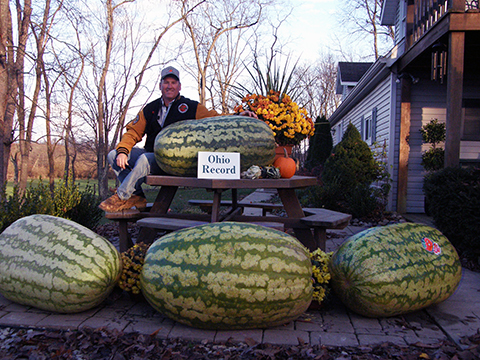I think you are right about soil making a big difference, and certainly everything I’ve ever read and heard says just what you did- sandy soils are better for watermelons. I’m not exactly sure how to define my soil, but its certainly not clay and it is somewhat sandy (though not like Georgia and Florida soil I’ve seen where sand seems to make up most of the soils).
I’m surprised to hear you think maybe you get too much rain for watermelons…but maybe that rain in combination with your soil type is a problem. For me, I’ve never felt too much rain was a problem for growing my watermelons, no matter how much we get. That being said, I do think that something Fruitnut says quite often is true…a deficit of water results in sweeter watermelons. However, in my own experience/opinion, the perfect situation is to get lots and lots of rain while the vines and then the melons are growing, then have it turn very dry about 2 weeks before harvest. I even try to create that scenario to some degree by watering when it gets too dry during growing season, but never water as harvest approaches.
I can also tell you that my experience with lack of rain (and lack of my watering them) is much less severe that fruitnut’s experience of loosing leaves in 7 days. Of course, we don’t the extreme heat he probably does in Texas, and our soils are not as sandy or porous I don’t think, so they probably hold moisture better. But some years my watermelons have gone as much as a month without rain, and they actually do quite well for 2 weeks an even up to the month time period, they don’t really die or even loose leaves, they just stop growing, and any forming/growing watermelons are much, much more likely to be deformed during drought conditions.
To answer another one of your questions, I actually plant my watermelons on “hills”. To some people with tractors and the right equipment, than can mean just a long row of raised dirt mounded up. To me, its done with a steel rake or hoe and I just make little individual “hills” about 2.5 foot x 2.5 foot. Allows proper drainage, makes finding the plant base much easier when I walk through patch to apply fertilize and all you can see are vines everywhere in a big mass. Also its just how I was taught to plant watermelons and have always done it, so I cannot swear it makes a big difference. In fact, this year I planted a lot without “hills” so I can evaluate if they help or not.
Finally, you ask about black plastic. Yes, lots of people grow watermelons that way, especially large commercial watermelon farms in GA and FL. (Cordell, GA is sort of the watermelon capital of the world if you didn’t know that). They have a big machine that does many of the things you just asked about all at one time: I goes through the field with an attachment that creates a long row of dirt piled up about 1 foot about the dirt around it- ie a long raised row of dirt. As the same time, the machine also lays down a long, long section of soaker hose, and then (in the same pass) spreads out black plastic that covers the raised row of dirt (ie the hill), So in one pass they create the long “hill” of dirt, put down soaker hose on or in that hill, and cover it with plastic. I think some even cut a place for the plants and might even insert plants or seeds, but I’m not sure on that last part.
I really don’t think I’m doing anything dramatically different from what you probably do to grow watermelons, which leads me to think weather, climate, soil, and other things must be the difference. That said, I’m a little doubtful rain is one the big reasons I have more success than you because- as I stated above- I have pretty good luck whatever the rain does (to a certain extent, anyway) hope some of that helped!



